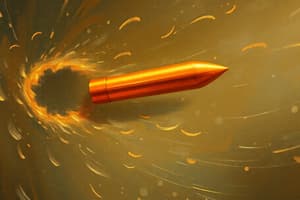Podcast
Questions and Answers
¿Qué se entiende por tiempo en el contexto del movimiento de un objeto?
¿Qué se entiende por tiempo en el contexto del movimiento de un objeto?
- La duración continua o secuencia en la que ocurren eventos. (correct)
- La distancia recorrida por un objeto en un período específico.
- La velocidad a la que se mueve un objeto.
- El cambio en la posición neta de un objeto.
¿Cuál es la relación entre el movimiento y el tiempo?
¿Cuál es la relación entre el movimiento y el tiempo?
- Un objeto siempre se mueve a la misma velocidad independientemente del tiempo.
- El movimiento de un objeto no está relacionado con el tiempo.
- El tiempo no influye en la rapidez de un objeto en movimiento.
- El movimiento de un objeto ocurre en relación con una duración específica. (correct)
¿Qué representa la distancia en el contexto del movimiento?
¿Qué representa la distancia en el contexto del movimiento?
- El cambio neto en la posición de un objeto.
- La trayectoria recorrida por un objeto en un tiempo determinado.
- La velocidad a la que se desplaza un objeto.
- La extensión o longitud entre dos puntos. (correct)
¿Cuál es la diferencia entre distancia y desplazamiento?
¿Cuál es la diferencia entre distancia y desplazamiento?
¿Qué se entiende por velocidad en el contexto del movimiento de un objeto?
¿Qué se entiende por velocidad en el contexto del movimiento de un objeto?
¿Cómo se puede calcular la velocidad de un objeto?
¿Cómo se puede calcular la velocidad de un objeto?
¿Qué es la velocidad?
¿Qué es la velocidad?
¿Qué es la aceleración?
¿Qué es la aceleración?
¿Qué representa un vector de posición?
¿Qué representa un vector de posición?
¿Cuál es la característica principal del movimiento de velocidad constante?
¿Cuál es la característica principal del movimiento de velocidad constante?
¿Qué es cinemática?
¿Qué es cinemática?
¿Qué tipo de movimiento ocurre cuando la velocidad de un objeto cambia?
¿Qué tipo de movimiento ocurre cuando la velocidad de un objeto cambia?
Flashcards are hidden until you start studying
Study Notes
Understanding Motion and Time
When we observe the world around us, we witness a fascinating dance of objects in motion. As we delve into this realm, we'll explore the essential connection between motion and time, which forms the backbone of our understanding of the physical universe.
Motion
Motion refers to the change in an object's position over time. This change can occur in terms of direction, speed, or both. For example, consider a ball being kicked across a field. The ball's motion can be described by its position in the field at different points in time.
Time
Time, on the other hand, is the continuous duration or sequence in which events occur. In essence, it's the order of occurrence of events. We measure time using units such as seconds, hours, and years. Motion occurs within the framework of time, meaning that if an object moves, it does so in relation to a specific duration.
Speed
Speed refers to the rate of an object's motion. If an object moves a certain distance in a specific amount of time, we can calculate its speed as the ratio of distance to time. For instance, if a car travels 100 meters in 20 seconds, its speed is 100 meters divided by 20 seconds, which equals 5 meters per second (m/s).
Distance
Distance denotes the extent or length between two points. In the context of motion, distance represents the path an object covers in a particular time.
Displacement
Displacement is the net change in an object's position. It's the final position minus the initial position of an object. Displacement is a vector quantity, meaning it has both magnitude and direction.
Velocity
Velocity is the rate of an object's displacement. It tells us how fast and in which direction an object is moving. It's the ratio of displacement to time.
Acceleration
Acceleration refers to the rate of change in an object's velocity. Acceleration can result from a change in speed, direction, or both. The SI unit for acceleration is meters per second squared (m/s²).
Position Vector
A position vector represents the position of an object relative to a fixed reference point. It's a directed line segment that extends from the origin to the point in space occupied by the object at a given instant in time.
Kinematics
Kinematics is the branch of physics that deals with the motion of objects without considering the causes behind the motion. It focuses on the relationships between position, time, speed, and acceleration.
Dynamics
In contrast to kinematics, dynamics is the branch of physics that deals with the causes of motion. It explores the factors that influence the motion of objects, such as forces, mass, and inertia.
Constant Velocity Motion
In constant velocity motion, an object moves a certain distance in equal intervals of time. This type of motion is characterized by a constant speed and a constant displacement in equal time intervals.
Accelerated Motion
Accelerated motion occurs when the velocity of an object changes. There are two kinds of accelerated motion: constant acceleration and variable acceleration.
Understanding motion and its relationship with time is essential in a diverse range of fields, from robotics and space exploration to everyday life and sports. As we continue to unravel the mysteries of our world and expand our knowledge into the universe, the concepts of motion and time remain fundamental building blocks of our understanding of the physical universe.
Studying That Suits You
Use AI to generate personalized quizzes and flashcards to suit your learning preferences.




